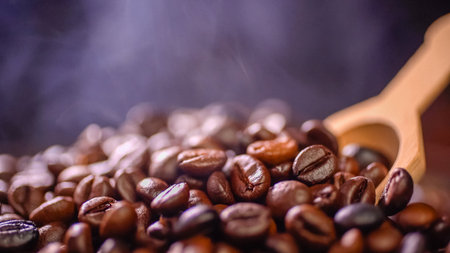1. The Art and Science of Coffee Cupping
If youve ever wondered how coffee pros in the United States decide which beans make it to your cup, the answer is simple: they cup coffee. Coffee cupping is a hands-on process that lets experts judge everything from flavor and aroma to body and acidity. Its a bit like wine tasting, but with a lot more slurping and some pretty strict rules.
What is Coffee Cupping?
Coffee cupping is a standardized way for coffee professionals to evaluate the quality of coffee beans. It’s used by roasters, importers, and baristas all across the U.S. The process involves brewing ground coffee with hot water in small bowls and then tasting it to pick up on different flavors and aromas.
Why Do American Coffee Professionals Cup Coffee?
Cupping isn’t just about enjoying good coffee—it’s an essential quality control tool. Here’s why it matters:
| Reason | Description |
|---|---|
| Consistency | Ensures every batch tastes as expected before hitting stores or cafes. |
| Transparency | Makes it easier to communicate specific flavors to customers and partners. |
| Fair Pricing | Helps set prices based on objective quality, which supports farmers and producers. |
| Improvement | Identifies strengths and weaknesses in beans so roasters can refine their process. |
The Cupping Experience in the U.S.
In the U.S., cuppings are often social events. Local roasteries or specialty cafes might invite customers to join in, making it a fun way to learn about coffee while connecting with others. Whether you’re a pro or just curious, cupping is at the heart of America’s vibrant coffee scene—helping everyone discover what makes each bean unique.
2. Tools and Setup: Cupping Lab Essentials
Coffee cupping in the U.S. is a ritual that’s all about consistency and accuracy. From indie coffee shops in Portland to major specialty roasters in San Francisco, professionals use specific gear and setups to make sure every bean gets a fair shot at showing its true flavors. Here’s how they do it:
Essential Equipment for U.S. Coffee Cupping
| Tool | Purpose | What Makes It Special? |
|---|---|---|
| Cupping Spoon | Tasting brewed coffee samples | Deep, round bowl for easy slurping; typically made of stainless steel for no aftertaste |
| Cupping Bowls | Holding ground coffee and hot water during tasting | Standard size (usually 6-7 oz); white or clear to see color clarity |
| Grinder | Grinding beans right before cupping to preserve freshness | Burr grinder preferred for uniform particle size; cleaned between samples to prevent cross-contamination |
| Kettle with Gooseneck Spout | Pouring hot water with precision over grounds | Allows even saturation of coffee grounds for consistent extraction |
| Scale | Measuring coffee and water accurately | Ensures precise ratios, crucial for comparing coffees fairly |
| Tasting Table | Workspace for arranging samples and moving around easily | Wide enough for multiple cups; often set at counter height for standing tastings; easy to clean surface is a must! |
| Tasting Forms & Pens | Recording notes on aroma, flavor, body, etc. | SCAA or customized forms common; helps keep track of impressions and scores systematically |
| Water & Rinsing Cups | Cleansing spoons between samples and palates between rounds | Prevents flavor carry-over from cup to cup; filtered water preferred for neutrality |
| Towels/Napkins | Quick clean-up of spills or drips during sessions | A must-have for keeping things tidy—coffee can get messy! |
| Spittoons or Dump Bowls | Discarding excess coffee after tasting (spitting out instead of swallowing) | Makes it possible to taste many coffees without caffeine overload; common in pro labs! |
The Ideal Cupping Environment in the U.S.
- Lighting: Bright, natural light is best so tasters can check color clarity and defects easily.
- Odor-Free Space: No perfumes, food smells, or other scents—these can mess with your sense of smell!
- No Distractions: Quiet rooms help cuppers focus on subtle flavor notes.
- Cleanliness: Surfaces, tools, and hands need to be spotless—cleanliness prevents contamination.
The American Standard: Consistency Matters!
No matter if you’re a barista-in-training or a certified Q Grader, using standardized equipment and setup means everyone judges each coffee under the same conditions. That’s why cupping labs across the country look pretty similar—precision is key to finding the best beans.
![]()
3. The Cupping Process: Step-by-Step
What Is Coffee Cupping?
Coffee cupping is a structured way that American coffee professionals use to judge the quality of coffee beans. It’s not just about sipping a cup of joe—it’s a ritual with specific steps and even its own etiquette. Here’s how it works in specialty coffee shops, roasteries, and competitions across the U.S.
The Stages of Coffee Cupping
| Stage | Description |
|---|---|
| 1. Grinding the Beans | Freshly roasted beans are ground to a medium-coarse consistency, right before cupping starts. This keeps the flavors fresh. |
| 2. Smelling the Grounds (“Dry Aroma”) | Tasters lean in to sniff the freshly ground coffee. This first impression hints at what flavors might be present after brewing. |
| 3. Adding Hot Water | About 200°F water is poured over the grounds in small cups or bowls, starting the brewing process. Tasters often set a timer for consistency. |
| 4. Breaking the Crust | After around 4 minutes, a crust of grounds forms on top. Tasters use a spoon to break this crust, releasing more aroma—this is a key moment for judging fragrance. |
| 5. Skimming & Cleaning | The floating grounds are skimmed off with spoons so only the brewed liquid remains. |
| 6. Tasting (“Slurping”) | Tasters use wide-bowled spoons to slurp coffee loudly. The slurp spreads coffee across the palate, helping identify subtle flavors, acidity, and mouthfeel. |
| 7. Scoring & Notes | Tasters jot down scores and notes on flavor, balance, sweetness, aftertaste, and more—often using SCA (Specialty Coffee Association) forms. |
Cultural Etiquette in American Coffee Cupping
- Loud slurping is encouraged: Unlike in daily life, loud slurping is totally acceptable during cupping sessions—it helps aerate the coffee and reveals more flavors.
- Sharing is common: Cuppers often use communal spoons but rinse between uses for hygiene.
- No judgment for spitting: Many tasters spit out samples like wine experts do; this helps them taste many coffees without getting over-caffeinated.
- Camaraderie and respect: Even though scoring can get competitive, there’s usually a friendly atmosphere focused on learning and discovery.
- Diversity of opinions: Everyone’s palate is different—there’s no “wrong” answer when describing what you taste!
4. Evaluating Flavor and Quality
Key Attributes Professionals Focus On
When American coffee professionals cup coffee, they look for specific qualities in each sample. These main attributes help them judge how good the beans are and how they might taste to customers. Here are the key things they pay attention to:
| Attribute | Description |
|---|---|
| Aroma | The smell of the coffee, both when it’s dry and after adding hot water. Professionals look for pleasant, fresh, or unique scents. |
| Body | The weight or thickness of the coffee in your mouth—think of it as how “full” or “light” the coffee feels when you drink it. |
| Acidity | This isn’t about sourness; it’s a bright, tangy quality that gives coffee its liveliness and sparkle. Good acidity is crisp and refreshing. |
| Aftertaste | The flavors that linger after you swallow. A nice aftertaste should be clean, sweet, or pleasantly complex. |
Using Scoring Sheets in the U.S.
In most American cupping sessions, professionals use scoring sheets to keep things fair and organized. The most popular system is the Specialty Coffee Association (SCA) form, which gives scores out of 100 points based on different qualities like aroma, flavor, acidity, body, balance, and more. Each attribute gets a number score—higher numbers mean better quality. This helps experts compare coffees side by side and talk about what makes each one special.
Typical Cupping Score Sheet Categories
- Aroma/Fragrance
- Flavor
- Aftertaste
- Acidity
- Body
- Balance
- Cup Cleanliness
- SWEETNESS (sometimes included)
- Overall Impression
How Scores Add Up
Add up all the category scores to get a total out of 100. In the U.S., coffees that score over 80 points are called “specialty grade”—that’s a big deal in the industry!
5. Impact on Coffee Sourcing and Industry Trends
How Cupping Results Shape Coffee Buying Decisions
Cupping is more than just tasting coffee—it’s the backbone of how American coffee professionals choose which beans make it into your morning cup. Roasters, importers, and café owners use cupping scores to decide what to buy, how much to pay, and which farms to build relationships with. A high score can turn a small farm’s lot into a hot commodity, while a low score might mean it doesn’t make the cut for specialty shelves.
Common Cupping Score Ranges and Their Buying Implications
| Cupping Score | Quality Level | Typical Action by Buyers |
|---|---|---|
| 90+ | Outstanding/Special Reserve | Premium pricing, exclusive offers, limited edition releases |
| 85-89.99 | Specialty Grade | Mainstream specialty purchase, featured in cafés and subscriptions |
| 80-84.99 | Very Good/Entry-Level Specialty | Bought in larger volumes, often for blends or house coffees |
| <80 | Commercial Grade | Usually not selected for specialty market in the U.S. |
The Role of Cupping in the Specialty Coffee Movement
Cupping has been key in raising the bar for quality across the U.S. coffee industry. It helps professionals discover unique flavors and origins, encouraging the rise of single-origin coffees and direct trade relationships. When a particular region or farm scores well at national cuppings or competitions, it often sparks new trends—think Ethiopian naturals or experimental fermentations—driving demand and innovation.
Recent Trends Driven by Cupping Practices:
- Focus on Transparency: More roasters now share cupping notes and scores directly with consumers.
- Diversity of Offerings: High-scoring lots from lesser-known regions gain traction faster thanks to cupping results.
- Sustainability: Direct trade deals are increasingly based on consistent cupping performance over several harvests.
- Education: Public cuppings and tasting events help demystify the process for everyday coffee drinkers.
The Bigger Picture: Shaping the U.S. Coffee Industry’s Future
Cupping doesn’t just influence what ends up in your cup—it also guides industry standards, pricing models, and even farmer incentives. As more U.S. professionals rely on cupping data to make sourcing decisions, they’re helping shape a more transparent, quality-focused coffee market that benefits both producers and consumers.


